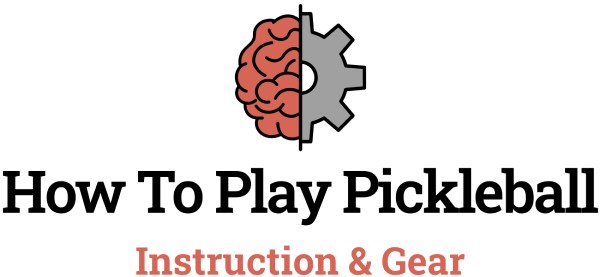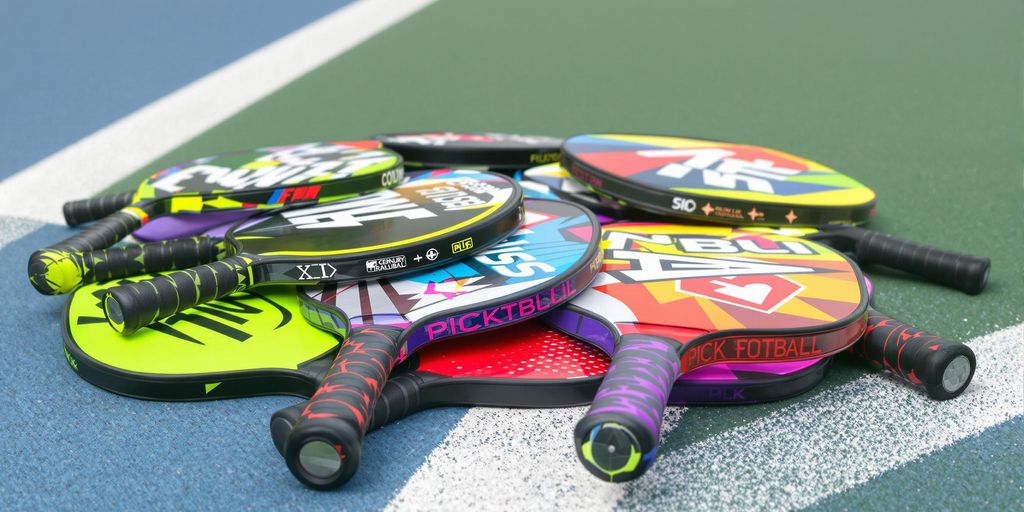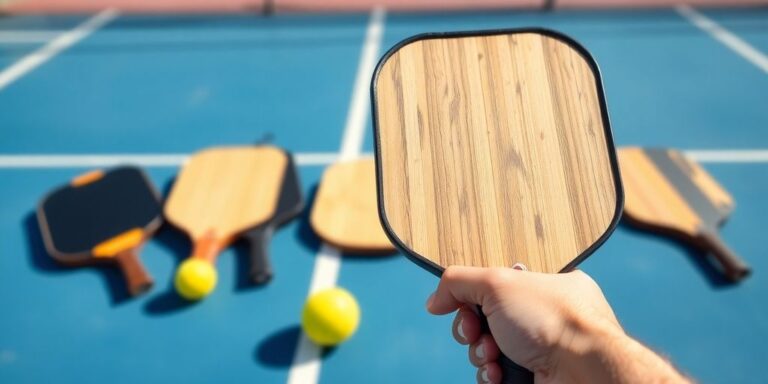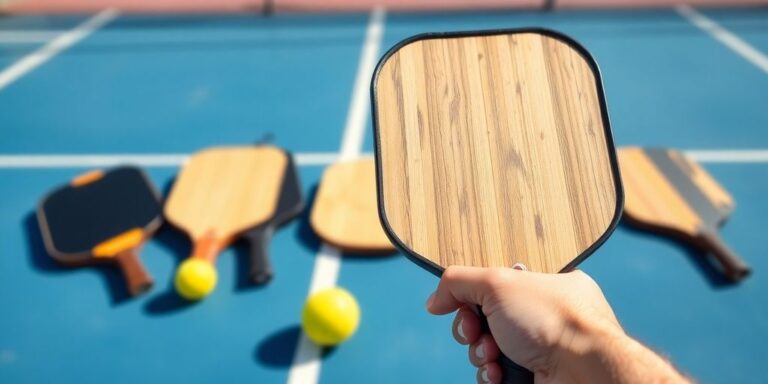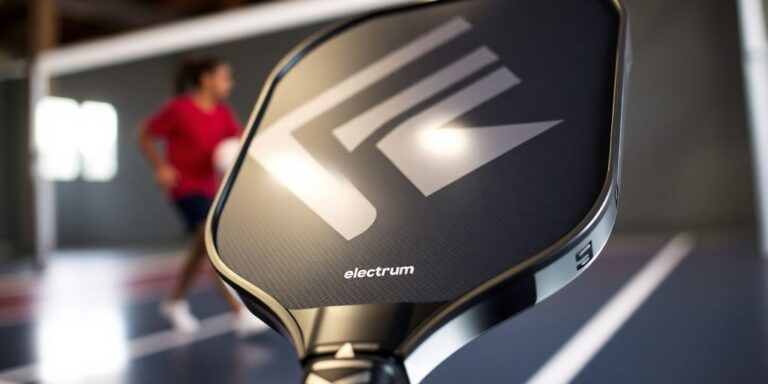Starting pickleball and unsure which paddle to pick? You’re not alone. The right paddle can make or break your first games. With so many choices, it’s easy to feel lost. This guide will walk you through what beginners need to know about pickleball paddles, so you can hit the court with confidence.
Key Takeaways
- Pick a lightweight paddle for better control as a beginner.
- Choose a grip size that feels comfortable in your hand.
- Materials like polymer cores and fiberglass faces are beginner-friendly.
- Avoid paddles that feel too heavy or too light for you.
- Test a few paddles before buying to find your best fit.
Understanding the Basics of Pickleball Paddles
Anatomy of a Pickleball Paddle
To choose the right paddle, you first need to understand its parts. A pickleball paddle is more than just a flat surface; it’s designed with specific components that affect how you play:
- Face: The paddle’s surface, usually made of fiberglass, graphite, or carbon fiber, determines how much spin and control you can achieve.
- Core: The inside of the paddle, often made from polymer, Nomex, or aluminum, impacts power and responsiveness.
- Handle: The length and grip size of the handle influence comfort and control. A shorter handle allows for better wrist movement, while a longer one provides extended reach.
- Edge Guard: Protects the paddle from damage. A thinner guard gives you more hitting surface, while a thicker one offers better durability.
Key Components That Affect Performance
Each part of the paddle plays a role in how it performs on the court. Beginners should consider the following:
- Weight: Heavier paddles provide more power, but lighter paddles are easier to maneuver.
- Grip Size: A grip that’s too small or too large can make it harder to control the paddle and may lead to discomfort.
- Material: Fiberglass surfaces are great for power, while graphite offers better control. Core materials like polymer are softer and quieter, ideal for beginners.
Why Beginners Should Focus on Basics
When you’re just starting out, it’s tempting to go for advanced features, but simplicity is key. A paddle that balances comfort and ease of use will help you develop your skills faster. Focus on:
- A medium-weight paddle to avoid fatigue.
- A grip size that feels natural in your hand.
- Durable materials that can withstand a few accidental hits.
Starting with the right paddle can make your introduction to pickleball smoother and more enjoyable. Don’t overthink it—stick to the basics, and you’ll be fine.
Factors to Consider When Choosing a Pickleball Paddle

Weight and Its Impact on Gameplay
The weight of a pickleball paddle can significantly affect your game. Paddles typically range from lightweight (6-7.5 ounces) to heavyweight (over 8.5 ounces). Lightweight paddles are easier to maneuver and great for quick reactions but may lack power. On the other hand, heavier paddles generate more powerful shots but can tire your arm faster. Mid-weight paddles strike a balance between the two, making them a popular choice for beginners. Think about your physical endurance and playing style when deciding on weight.
Grip Size for Comfort and Control
Grip size is all about how the paddle feels in your hand. A paddle with the right grip size provides better control and reduces the risk of injury. Measure your hand or test paddles to find what feels most comfortable. Smaller grips allow for more wrist action and spin, while larger grips offer stability. As a general rule, if you’re unsure, go smaller—you can always add an overgrip to adjust.
Material and Durability for Long-Term Use
Pickleball paddles are made from various materials, each impacting performance and durability. Common core materials include polymer (soft feel, good control), Nomex (harder, more power), and aluminum (lightweight, less durable). For the surface, fiberglass offers a good mix of power and control, graphite is lightweight and precise, and carbon fiber is durable but pricier. Beginners often do well with composite paddles, which balance cost and performance.
Different Types of Pickleball Paddles for Beginners

Lightweight vs. Heavyweight Paddles
When it comes to paddle weight, there’s no one-size-fits-all. Lightweight paddles (under 7.3 ounces) are easier to maneuver, making them a great choice for beginners who want to focus on control and quick reactions. On the other hand, heavyweight paddles (over 8.3 ounces) deliver more power but can be tiring for extended play. Midweight paddles (7.3 to 8.3 ounces) strike a balance, offering both control and power, making them a versatile option for new players.
| Weight Category | Weight Range | Best For |
|---|---|---|
| Lightweight | Under 7.3 ounces | Control and quick reactions |
| Midweight | 7.3 to 8.3 ounces | Balanced performance |
| Heavyweight | Over 8.3 ounces | Power-oriented gameplay |
For a detailed breakdown of weight categories, check out this guide.
Core Materials: Polymer, Nomex, and Aluminum
The core of a paddle determines its feel and performance. Polymer cores are soft and quiet, making them ideal for beginners who want a forgiving paddle. Nomex cores are harder and louder, offering more power but less control. Aluminum cores, while lightweight, provide excellent control and are perfect for players focusing on precision.
- Polymer Core: Soft, quiet, beginner-friendly.
- Nomex Core: Hard, loud, power-focused.
- Aluminum Core: Lightweight, control-oriented.
As a beginner, a polymer core paddle is usually your safest bet for balanced gameplay.
Surface Materials: Fiberglass, Graphite, and Carbon Fiber
The surface material affects how the ball interacts with the paddle. Fiberglass paddles are known for their power and affordability, making them a popular choice for newcomers. Graphite paddles are lighter and offer more control, ideal for players who prioritize finesse. Carbon fiber paddles are the most durable but can be pricey, offering a blend of power and control.
- Fiberglass: Affordable, power-focused.
- Graphite: Lightweight, control-focused.
- Carbon Fiber: Durable, balanced performance.
If you’re just starting, a fiberglass or graphite paddle can help you find your footing without breaking the bank. For more beginner-friendly options, explore this guide.
How to Match a Paddle to Your Playing Style
Paddles for Power-Oriented Players
If you’re the type of player who loves to hit hard and dominate with power, you’ll want a paddle that can amplify your strength. Heavier paddles, typically weighing around 8.5 ounces or more, are ideal for generating powerful shots. These paddles often come with elongated or hybrid shapes, giving you extra reach and stability. However, keep in mind that heavier paddles can be tiring over time, especially during long matches. Finding the right balance between weight and comfort is key.
| Paddle Feature | Ideal for Power Players |
|---|---|
| Weight | 8.5 oz and above |
| Shape | Elongated or hybrid |
| Core Material | Polymer or Nomex |
For more details on choosing the right paddle for power, check out our guide on power paddles.
Options for Control-Focused Beginners
If you’re just starting out and prefer precision over power, lighter paddles are your best bet. These paddles are easier to maneuver, making them great for beginners who want to focus on accuracy and ball placement. Look for paddles weighing between 7.3 and 8.0 ounces. A smaller grip size can also help you maintain better control, especially if you have smaller hands. Materials like fiberglass are excellent for providing a softer touch, which is perfect for control-oriented play.
- Weight: 7.3 – 8.0 oz
- Grip Size: Small to medium (4-4.25 inches)
- Material: Fiberglass for a softer feel
Balanced Paddles for All-Round Performance
Some players like to mix it up—one moment they’re smashing the ball, and the next, they’re placing it delicately over the net. If this sounds like you, a balanced paddle offers the best of both worlds. These paddles usually fall in the mid-weight range (around 8.0 ounces) and are built with materials like graphite or carbon fiber, which combine power and control. A medium grip size is also a good choice for versatility.
Pro Tip: If you’re unsure about your playing style, start with a balanced paddle. It’s a safe choice that can adapt as your skills and preferences evolve.
By understanding your playing style and matching it to the right paddle, you’ll not only improve your performance but also enjoy the game more. Remember, there’s no one-size-fits-all solution, so take the time to experiment and find what works for you. For more tips on selecting the perfect paddle, explore our pickleball paddle guide.
Common Mistakes Beginners Make When Choosing a Paddle
Overlooking the Importance of Weight
One of the biggest rookie mistakes? Not paying attention to paddle weight. A paddle that’s too heavy can wear you out quickly, while one that’s too light might not give you enough power. Beginners often grab whatever looks good without realizing how much weight affects their control and stamina. Ideally, test a few paddles to figure out what feels right for your strength and style.
Choosing the Wrong Grip Size
Another common misstep is picking a paddle with the wrong grip size. If the grip is too small, you’ll find yourself over-gripping, which can lead to wrist strain. Too large, and you’ll lose control over your shots. A quick tip: measure from the tip of your ring finger to the second crease in your palm for a good starting point.
Ignoring Material and Build Quality
Some beginners focus only on price and forget to consider the paddle’s material and construction. While it’s tempting to go for the cheapest option, poorly made paddles won’t last and might even hold back your progress. Look for materials like polymer cores and fiberglass or graphite surfaces for a balance of durability and performance.
Taking the time to research and test paddles can save you frustration and even money in the long run. A well-chosen paddle will grow with your skills and make the game more enjoyable.
For those starting out, choosing the right lightweight pickleball paddle can help you develop better control and comfort, especially during longer games. Avoid these pitfalls, and you’ll be off to a solid start!
Top Tips for First-Time Pickleball Paddle Buyers
Set a Budget Before Shopping
Before you even start browsing, decide how much you’re willing to spend. There are paddles for every price range, and it’s easy to get overwhelmed by options. For beginners, sticking to an affordable yet reliable paddle is often the best route. You can always upgrade later when you’ve developed your skills. A good starting point is between $50 and $100—this range offers decent quality without breaking the bank.
Test Paddles Before Making a Decision
Whenever possible, try out a few paddles before committing to one. Many sports stores or pickleball clubs offer demo paddles for this exact purpose. Testing helps you figure out what feels comfortable in your hands and suits your playing style. Pay attention to the weight, grip, and overall balance during your trial runs. Don’t rush—take your time to find a paddle that feels just right.
Seek Advice from Experienced Players
Seasoned players are a great resource when you’re starting out. They’ve been through the trial-and-error phase and can offer valuable insights. Ask them about their first paddle, what they liked or disliked, and any recommendations they might have for beginners. You can even borrow a paddle from someone to get a feel for different types.
Starting with the right paddle can make your first games more enjoyable and set you up for steady improvement. Don’t underestimate the importance of finding a paddle that fits your needs and comfort level.
If you’re new to pickleball and looking to buy your first paddle, there are a few key things to keep in mind. First, think about the weight and grip size that feels comfortable for you. A lighter paddle can help with control, while a heavier one may offer more power. Don’t forget to check the material; paddles made from composite materials are often a great choice for beginners. For more tips and to explore the best paddles available, visit our website today!
Wrapping It Up
Getting started with pickleball is exciting, and picking the right paddle is a big part of that journey. While it might seem like a lot to think about—weight, grip size, materials—just remember to focus on what feels comfortable and suits your style. As you play more, you’ll figure out what works best for you. Don’t stress too much about finding the "perfect" paddle right away. The most important thing is to get out there, have fun, and enjoy the game. Happy playing!
Frequently Asked Questions
What should beginners look for in a pickleball paddle?
Beginners should focus on paddles that are lightweight, have a comfortable grip size, and offer a good balance of power and control.
How does the weight of a paddle affect gameplay?
A lighter paddle is easier to control and ideal for beginners, while a heavier paddle provides more power but may tire your arm faster.
What materials are used in pickleball paddles?
Pickleball paddles are often made from materials like graphite, fiberglass, and carbon fiber for the surface, and polymer, aluminum, or Nomex for the core.
How do I pick the right grip size for my paddle?
To find the right grip size, measure the distance from the middle of your palm to the tip of your ring finger. A proper grip size ensures comfort and control.
Can I use the same paddle for indoor and outdoor pickleball?
Yes, most paddles work for both indoor and outdoor play, but outdoor balls are heavier and may affect how the paddle performs.
Do I need to spend a lot of money on my first paddle?
Not necessarily. Many affordable paddles offer great features for beginners. Focus on finding one that meets your needs without breaking the bank.
